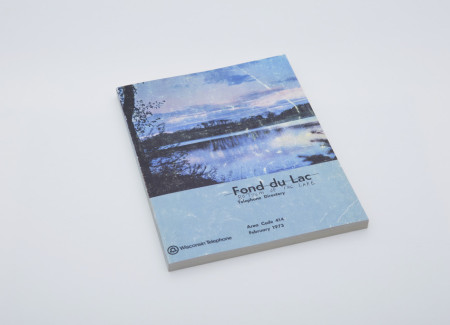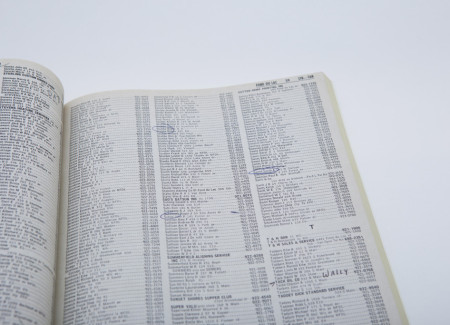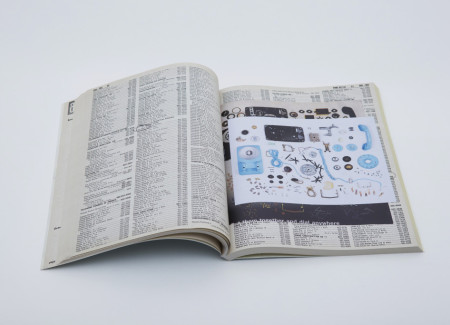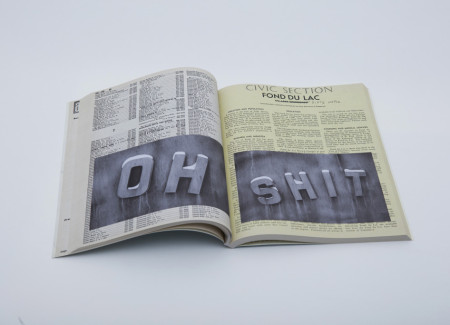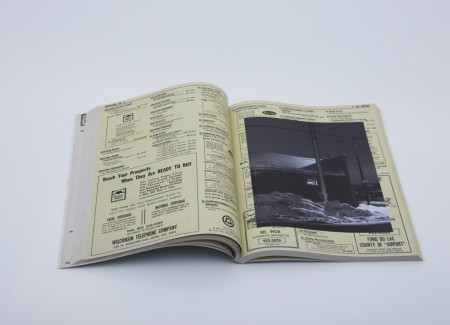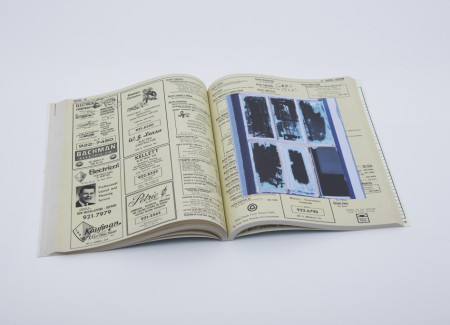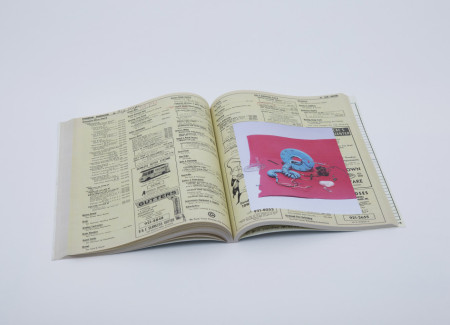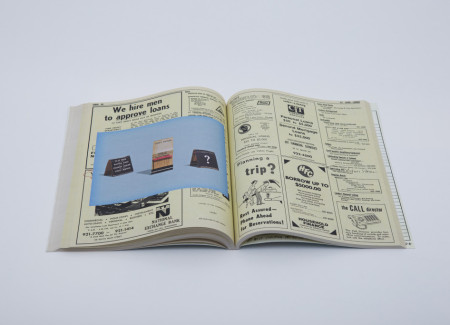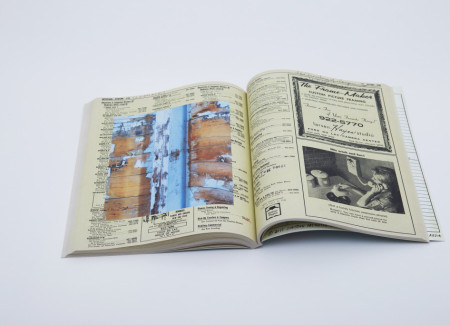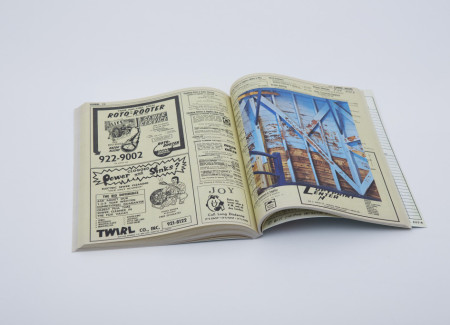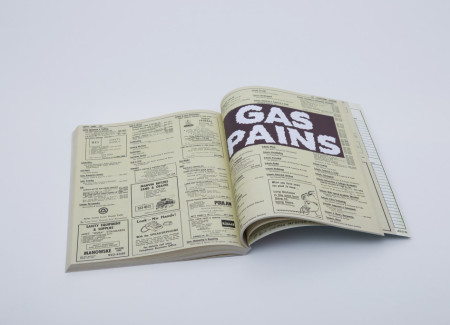JTF (just the facts): Published by Walther König in 2015 (here). Softcover, 176 pages, with 71 photographs, drawings and reproductions. There are no formal essays, but markings and marginalia throughout. (Cover and spread shots below.)
Comments/Context: Christian Patterson has become known for his forensically-charged documentary style of visual storytelling, and his most recent photobook, Bottom of the Lake, continues with this in-depth approach. It is a book within a book – an artist book, created within a true-to-life facsimile of the original 1973 telephone directory from his hometown in Fond du Lac, Wisconsin. It playfully interweaves two diverse narratives – the factual directory itself (and what it tells about that Midwestern town at that time) and the artistic re-imagination of a particular place – as they overlap, puzzle together, and reinforce each other. It’s an indirect trip home, reconstructing and reinterpreting his hometown’s iconography, culture, and climate using the humble phonebook as an unorthodox storytelling framework.
The beat-up old phonebook owned by his family provides a starting point, and Patterson has overlaid its commonplace white and yellow pages with various interventions and interruptions: photographs, drawings, markings, appropriated material and other scribblings, jottings, and marginalia. Published just a year after he was born, it takes us back to February 1973, to the Patterson’s hometown at the southern end of Lake Winnebago; French explorers gave Fond du Lac its name, and it wasn’t a hugely inspired selection – it means “bottom (or foot) of the lake”.
In Patterson’s hands, the outdated telephone directory gets a second life, tracing elements of the past in the present, and serving now as an index of other things. While the title references the literal translation from French (and is crossed out and replaced with a handwritten English stand-in), together with a slightly scratched and faded image of the lake on the cover, it sets the mood for the book experience – it is murky, mysterious, and generally cold. The interaction between the context of the book and Patterson’s interjected narrative starts right from the cover, and as the elements interconnect and reference each other, a multi-layered visual flow unfolds that requires attentive focus and even some problem solving.
Scrawled markings and other interventions help to set the tone of the narrative, but don’t provide clear direction. Near the beginning, a big text panel broken in three lines reads like an invitation: “WHAT LIES AHEAD?” Various drawings and highlights play with the dull content of the original phone book, adding a layer of dark teenage humor, like bored doodles while made on hold. With the mark of a pen, “Jet Stream Car Wash” turns into “Wet Dream Car Wash”, while “Ed. Pick” is now “Red. Dick”. Next to Mississippi (in a section for long distance calling), he inserts “I pee pee” (in capital letters) – now it rhymes. In addition to the juvenile joking, more refined insertions include wry commentary on President Nixon and the oil crisis of 1973 (“Save your gas for Nixon” and “Nixon wired his phone”).
After a few page flips, it becomes clear that Patterson has marked numerous bars and taverns listed in the directory. Is it a reference to the drinking culture of Fond du Lac?; indeed, the town of 45000 residents seems to have a significant concentration of bars and drinking establishments, and Patterson has set out to discover which ones from 1973 still exist today. His black and white photographs capture the exteriors of these snow-covered pubs; photographed on a winter night, they are dark, cold and distant, lifeless in the harsh winter weather.
There is a pervading silence in Patterson’s pictures, providing little direct information about the town of Fond du Lac or its residents. He shuffles images of the lakefront, the snowy ground, block walls, and up close wood grain, setting the mood. Two main subjects – an old rotary phone and a lighthouse – recur throughout the book. The powder blue phone, held by hands in white gloves, appears early in the book, and we see it again as it is disassembled, down to the tiniest single elements perfectly laid out on a clean white background, and reassembled once more. Detached from its functionality, the object becomes a sculpture. Seen repeatedly, the phone offers several symbolic readings – an icon of passing time, an object of now obsolete utility, a communication device that may or may not still allow us to connect to others. Another set of images depicts the famous Fond du Lac lighthouse (another communicating object), built in the 1930s, and its surrounding landscape. Patterson’s photographs go inside, capturing close ups of wooden stairs, painted walls and support structures that change the town’s most recognisable landmark into an unknown abstraction, detaching it from its familiar context.
The repetition of formal patterns (as seen in snow, water, stone and wood) dominates Patterson’s visual narrative, and in Patterson’s often abstract and fragmented photographs, the diverse materials start to resemble one another even more. The color palette becomes another key element, with a particular accent on blue as it progresses through the book (starting from the cover, and reappearing in images of the phone, lake, lighthouse and other smaller details). When Patterson uses monochrome imagery, its black and white tones feel like deliberate color choices as well.
In a surprising twist, the interaction with the book actually extends beyond its pages. The phone number on the back cover connects to over 100 audio recordings, ranging from conversations and weather reports to unrecognizable sound bites, recreating experiences from Fond du Lac. These archival materials, with their poor quality and distant dial up feel, add another reference to the old times.
Bottom of the Lake is not a typical return to a fondly remembered hometown – Patterson’s enigmatic photographs are more atmospheric than documentary, and offer few concrete details about his life there. If anything, his indirect amalgamation of references leads to a remembered feeling of muted alienation, balanced by a present-day recall and recreation of that moment in time. The book’s non-linear narrative, as it unfolds through several layers of fact and fiction, creates a stream of visual puzzles, obtuse links, and factual allusions that feel like cues and clues. Bottom of the Lake takes an innovative approach in plumbing the depths of memory, and its many mysteries are never entirely resolved.
Collector’s POV: Christian Patterson is represented by Rose Gallery in Santa Monica (here) and Robert Morat Galerie in Berlin and Hamburg (here). His work has little secondary market history at this point, so gallery retail remains the best option for those collectors interested in following up.
